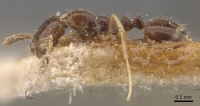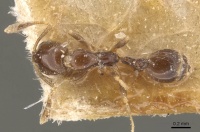Monomorium bequaerti
| Monomorium bequaerti | |
|---|---|

| |
| Scientific classification | |
| Kingdom: | Animalia |
| Phylum: | Arthropoda |
| Class: | Insecta |
| Order: | Hymenoptera |
| Family: | Formicidae |
| Subfamily: | Myrmicinae |
| Tribe: | Solenopsidini |
| Genus: | Monomorium |
| Species: | M. bequaerti |
| Binomial name | |
| Monomorium bequaerti Forel, 1913 | |
Nothing is known about the biology of Monomorium bequaerti.
Identification
Bolton (1987) - A member of the M. bequaerti complex in the M. monomorium species group. Of the Afrotropical species in which the antennae are 11-segmented three, bequaerti, Monomorium pulchrum and Monomorium rosae, have a relatively large and characteristically shaped postpetiole. Among these three species rosae is a fairly common West and Central African form which is very dark in colour, being blackish brown to black. The other two are much lighter, and apparently less common. M. pulchrum from Zimbabwe is dull yellow and bequaerti from Zaire is glossy light brown. Apart from its colour bequaerti is characterized by its relatively high narrow petiole node which in dorsal view is longer than broad. In both other species the petiole node is conspicuously broader than long in dorsal view.
Keys including this Species
Distribution
Distribution based on Regional Taxon Lists
Afrotropical Region: Democratic Republic of Congo (type locality).
Distribution based on AntMaps
Distribution based on AntWeb specimens
Check data from AntWeb
Countries Occupied
| Number of countries occupied by this species based on AntWiki Regional Taxon Lists. In general, fewer countries occupied indicates a narrower range, while more countries indicates a more widespread species. |

|
Estimated Abundance
| Relative abundance based on number of AntMaps records per species (this species within the purple bar). Fewer records (to the left) indicates a less abundant/encountered species while more records (to the right) indicates more abundant/encountered species. |

|
Biology
Castes
Nomenclature
The following information is derived from Barry Bolton's Online Catalogue of the Ants of the World.
- bequaerti. Monomorium (Martia) bequaerti Forel, 1913b: 334 (w.) DEMOCRATIC REPUBLIC OF CONGO.
- Type-material: syntype workers (number not stated).
- Type-locality: Democratic Republic of Congo (“Congo belge”): Katanga, Elisabethville (= Lubumbashi), 20.iii.1912 (Bequaert).
- Type-depositories: MHNG, MRAC.
- Combination in M. (Lampromyrmex): Wheeler, W.M. 1922a: 875.
- Status as species: Emery, 1922e: 183; Wheeler, W.M. 1922a: 875; Santschi, 1926b: 239; Ettershank, 1966: 87; Bolton, 1987: 379 (redescription); Bolton, 1995b: 259.
- Distribution: Democratic Republic of Congo.
Unless otherwise noted the text for the remainder of this section is reported from the publication that includes the original description.
Description
Worker
Bolton (1987) - TL 1.9, HL 0.50, HW 0.38, CI 76, SL 0.36, S1 95, PW 0.25, AL 0.54.
Clypeal carinae moderately strongly developed and widely divergent anteriorly. Maximum diameter of eye 0.21 x HW and with 5 ommatidia in the longest row. Outer ring of ommatidia enclosing more than one longitudinal row. In full-face view the eyes conspicuously in front of the midlength of the sides and the scapes, when laid straight back, failing to reach the occipital margin. Antennae with 11 segments. Sides of head evenly very shallowly convex in full-face view, the occipital margin exceptionally shallowly concave, almost transverse. Promesonotal dorsum in profile convex, sloping posteriorly to the shallow and only feebly impressed metanotal groove. Propodeum convex and broadly rounded, the spiracle pinhole-like. Nodes of petiole and postpetiole longer than broad in dorsal view. In profile the petiole node a high, relatively narrow, bluntly subconical structure. Subpetiolar process a narrow rim anteroventrally. Postpetiole in profile with a shallowly convex anterior face, broadly rounded dorsum and very long gradually sloping posterior face , the postpetiole relatively large, about the same size as or even slightly larger than the petiole. Except for small hair-pits, cross-ribbing at the metanotal groove and some faint vestiges on the pleurae sculpture is absent from the head and body; all surfaces except those mentioned being smooth and highly polished. All dorsal surfaces of head and body with standing hairs present, the promesonotum with 5 pairs. Colour a light glossy brown.
Type Material
Bolton (1987) - Syntype workers, Zaire: Elizabethville, 20.iii.1912 (Bequaert) (Musee Royal de I' Afrique Centrale, Musee d'Histoire Naturelle Genève) [examined].
References
- Bolton, B. 1987. A review of the Solenopsis genus-group and revision of Afrotropical Monomorium Mayr (Hymenoptera: Formicidae). Bulletin of the British Museum (Natural History). Entomology. 54: 263-452.. (page 379, see also)
- Forel, A. 1913b. Formicides du Congo Belge récoltés par MM. Bequaert, Luja, etc. Rev. Zool. Afr. (Bruss.) 2: 306-351 (page 334, worker described)
- Wheeler, W. M. 1922j. Ants of the American Museum Congo expedition. A contribution to the myrmecology of Africa. VIII. A synonymic list of the ants of the Ethiopian region. Bull. Am. Mus. Nat. Hist. 45: 711-1004 (page 875, Combination in M. (Lampromyrmex))
References based on Global Ant Biodiversity Informatics
- Ettershank G. 1966. A generic revision of the world Myrmicinae related to Solenopsis and Pheidologeton (Hymenoptera: Formicidae). Aust. J. Zool. 14: 73-171.
- Forel A. 1913. Formicides du Congo Belge récoltés par MM. Bequaert, Luja, etc. Revue Zoologique Africaine (Brussels). 2: 306-351.

